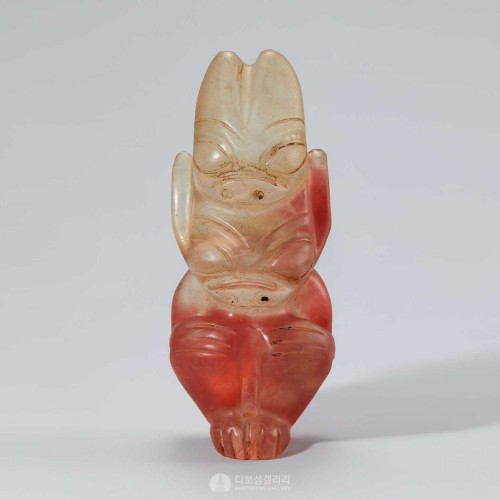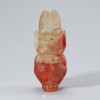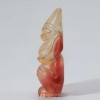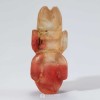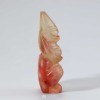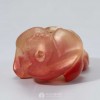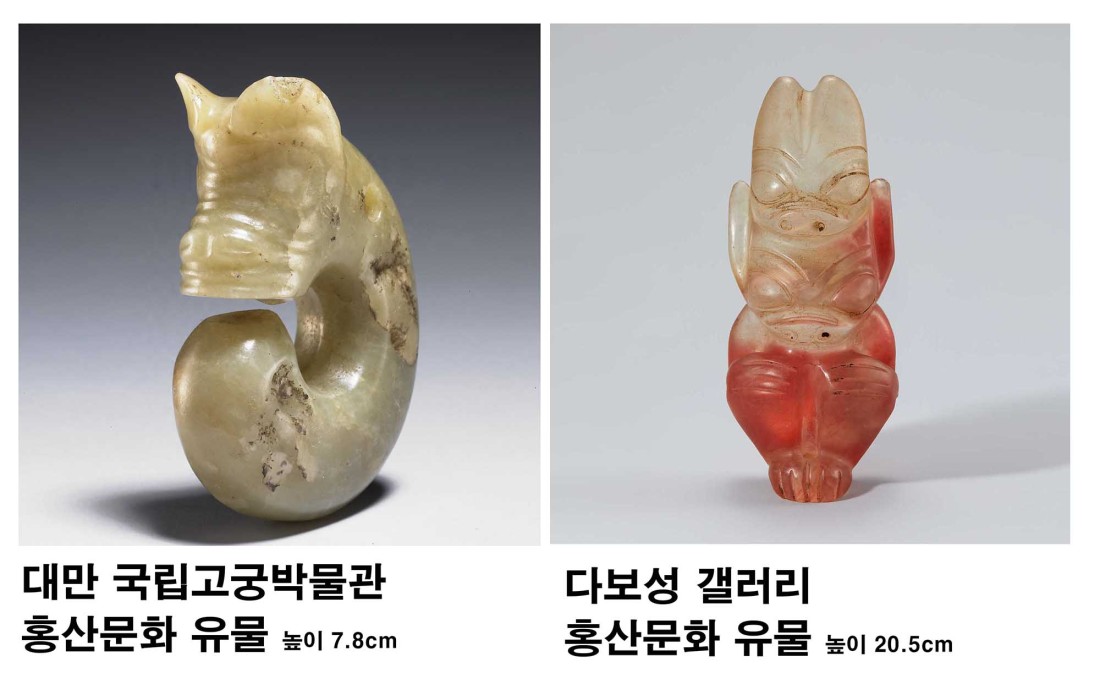본문
태양신과 매미를 융합시킨 제품이다. 태양신은 두 발을 모으고 두손을 무릎에 얹은 채 무릎을 구부린 자세로 쪼그려 앉아있고 머리 위에 매미를 올려 놓았다. 태양신의 얼굴 특징이 매미와 같아, 마치 두개의 머리가 있는 쌍두 태양신인 것만 같은 착각을 일으킨다. 전체적으로 동글동글한 모양에 신강옥의 붉은빛과 광택이 나며 생동감 넘치고 신비로운 느낌이 물씬 풍긴다.
신강옥(新疆玉)은 허톈을 비롯한 신강 지역에서 나는 다양한 옥을 일컫는다. 중국 서부의 실크로드의 한 갈래를 따라 위치한 허톈은 다양한 옥의 주요 역사적 원천으로, 최고 품질의 양지옥과 비취가 특히 유명한 곳이다.
홍산문화는 기원전 4700년부터 기원전 2900년 사이에 중화인민공화국 내몽골과 랴오닝성에 존재했던 신석기 시대의 문화다. 명칭은 옥기(玉器) 등 신석기시대 유물이 다량으로 출토된 내몽골자치구의 츠펑시(赤峯市)에 있는 붉은 산[紅山]에서 유래한다. 이 시대의 뉘우허량(牛河梁) 유적의 여신묘(女神墓)에서는 눈을 비취로 만든 여신상(女神像)을 비롯해 곰·용·거북·멧돼지 등의 동물 모양의 옥기가 다량으로 발견되었다. 홍산문화는 문자와 청동기가 없던 시대임에도 국가 단계로 보고 있다. 그 이유는 다량의 옥기가 출토되었기 때문이며, 이에 홍산문화를 ‘옥기 시대’로 규정하기도 한다.
此器是太阳神与蝉的复合器 。太阳神呈蹲坐姿势,双膝曲起,双脚并拢,双手扶膝,头顶一蝉。太阳神的面部特征与上方的蝉一致,给人带来一种双头太阳神的错觉。通体抛光圆润,有红色深浅沁色 。造型生动、传神,充满神秘气息 。
新疆玉是指以和田为首的新疆地区盛产的各种玉的统称。和田位于中国西部丝绸之路的支线上,是各种玉器的主要历史产地,尤其以出产顶级玉器和翡翠而闻名。
红山文化是存在于现代中华人民共和国内蒙古和辽宁省的新石器时代的文化,也被称为“红山文明”。名称来源于出土大量玉器等新石器时代文物的内蒙古自治区赤峰市的红山。在中国,红山文化与其他新石器时代的兴隆洼文化、赵宝沟文化、新乐文化等一起被规定为“辽河文明”。红山文化后期以狩猎、采集为中心,形成了基础性农作物,饲养家畜的畜产也很发达。在该时代的牛河梁遗址的女神墓中,发现了大量以翡翠做成眼睛的女神像、熊、龙、龟、野猪等动物模样的玉器。通过切割玉器时使用的工具可以看出,这里存在过制作玉器的工匠团体。从现有历史学的角度来看,进入国家阶段的最有力证据是文字和青铜器,红山文化在没有文字和青铜器的时代,但被看作是国家阶段的理由正是因为出土了大量玉器,因此红山文化也被定义为“玉器时代”。
A Xinjiang jade figurine shaped like a sun god and a cicada combined together. The sun god is squatting down with his hands on his knees and the cicada on his head. The glossy jade is mysterious red. Xinjiang is one of the areas that is very rich in jade of high quality and variety. With its clear material, Xinjiang jade was often used for crafts of Hongshan culture.
The Hongshan culture was a Neolithic culture stretching from Inner Mongolia to Liaoning and dated from about 4700 to 2900 BC. The culture is named after Hongshan(红山), a site in Hongshan District, Chifeng, where many Neolithic artifacts, such as jade ware, have been excavated. In China, Hongshan culture is defined as a "Liao River(遼河) Civilization" along with other Neolithic cultures such as Xinglongwa culture, Zhaobaogou culture, and Xinle culture. Hunting and gathering were the primary means of food supply, and basic cultivation and domestication of cattle also started in the late Hongshan. A clay goddess head with jade inlaid eyes was discovered in "the Goddess Temple" at Niuheliang, along with many animal jades such as bears, dragons, turtles, wild boars, and so on. The tools for cutting jades were found, which proves that a group of craftsmen made jade ware here. From the historical perspective, the invention of bronze ware and writing is the most convincing evidence of entering nation-states. However, Hongshan culture is regarded as a nation even without bronze ware and a writing system because of many jade wares excavated from the site, which made Hongshan culture defined as the 'Jade Age.'
